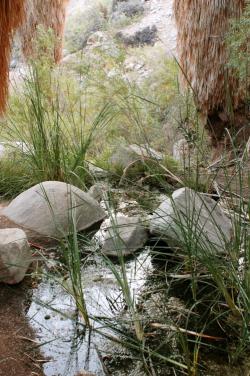Hydrology
Water infiltration enables desert plants to capitalize on rare and variable precipitation events.1 Plants can improve water infiltration by physically slowing down vertical and horizontal water movement.2 Plant stems and foliage break up raindrops, with water both flowing down the stems and into root channels in the soil, and dripping more slowly off of foliage.3 By slowing down precipitation, plants increase water infiltration into the soil. Vegetation patches can also slow the horizontal movement of water across the surface of the soil by obstructing runoff.4 By trapping water runoff, vegetation patches experience enhanced plant growth, creating greater plant densities within a vegetation patch, and a greater ability of the vegetation patch to trap water, resulting in a positive feedback cycle.5 Vegetation patches can also encourage more active soil macroinvertebrates (e.g. termites, ants, and earthworms).6 Macroinvertebrates and plant roots move and mix the soil through burrowing and excavating, root penetration and decay, in a process called “bioturbation.”7 The spaces, or macropores, generated by bioturbation can improve water movement and infiltration through the soil.8,9

In addition to altering the movement of water across the landscape, plants affect soil moisture by modifying the environment beneath and around them. For example, soil beneath the canopies of woody plants can have temperatures that are as much as 10 degrees Celsius lower than soils that not beneath plant canopies.10 Lower soil temperatures substantially reduce soil evaporation rates and loss of soil moisture.11
Aquatic habitats in deserts include pools, rivers, springs, and seeps (Figure 1). Fed by underground freshwater aquifers, they support a variety of sensitive and rare species. Desert springs are just one example of a rare aquatic habitat.12
1 W.G. Whitford, Ecology of Desert Systems, (San Diego: Academic Press, 2002).
2 W.G. Whitford, Ecology of Desert Systems, (San Diego: Academic Press, 2002).
3 W.G. Whitford, Ecology of Desert Systems, (San Diego: Academic Press, 2002).
4 J.A. Ludwig, B.P. Wilcox, D.D. Breshears, D.J. Tongway, and A.C. Imeson, “Vegetation Patches and Runoff-Erosion as Interacting Ecohydrological Processes in Semiarid Landscapes,” Ecology 86, no. 2 (2005): 288-297.
5 J.A. Ludwig, B.P. Wilcox, D.D. Breshears, D.J. Tongway, and A.C. Imeson, “Vegetation Patches and Runoff-Erosion as Interacting Ecohydrological Processes in Semiarid Landscapes,” Ecology 86, no. 2 (2005): 288-297.
6 J.A. Ludwig, B.P. Wilcox, D.D. Breshears, D.J. Tongway, and A.C. Imeson, “Vegetation Patches and Runoff-Erosion as Interacting Ecohydrological Processes in Semiarid Landscapes,” Ecology 86, no. 2 (2005): 288-297.
7 E.J. Gabet, O.J. Reichman, and E.W. Seabloom, “The Effects of Bioturbation on Soil Processes and Sediment Transport,” Annual Review of Earth and Planetary Sciences 31 (2003): 249-273.
8 E.J. Gabet, O.J. Reichman, and E.W. Seabloom, “The Effects of Bioturbation on Soil Processes and Sediment Transport,” Annual Review of Earth and Planetary Sciences 31 (2003): 249-273.
9 W.G. Whitford, “Subterranean termites and long-term productivity of desert rangelands,” Sociobiology 19, no. 1 (1991): 235-243.
10 D.D. Breshears, J.W. Nyhan, C.E. Heil, and B.P. Wilcox, “Effects of woody plants on microclimate in a semiarid woodland: Soil temperature and evaporation in canopy and intercanopy patches,” International Journal of Plant Sciences 159, no. 6 (1998): 1010-1017.
11 D.D. Breshears, J.W. Nyhan, C.E. Heil, and B.P. Wilcox, “Effects of woody plants on microclimate in a semiarid woodland: Soil temperature and evaporation in canopy and intercanopy patches,” International Journal of Plant Sciences 159, no. 6 (1998): 1010-1017.
12 W.D. Shepard, “Desert springs – both rare and endangered,” Aquatic Conservation: Marine and Freshwater Ecosystems 3 (1993): 351-359.
